Navigation: GPS waypoint navigation - most common mistakes and tips and tricks
Sven M. Rutter
· 13.11.2024
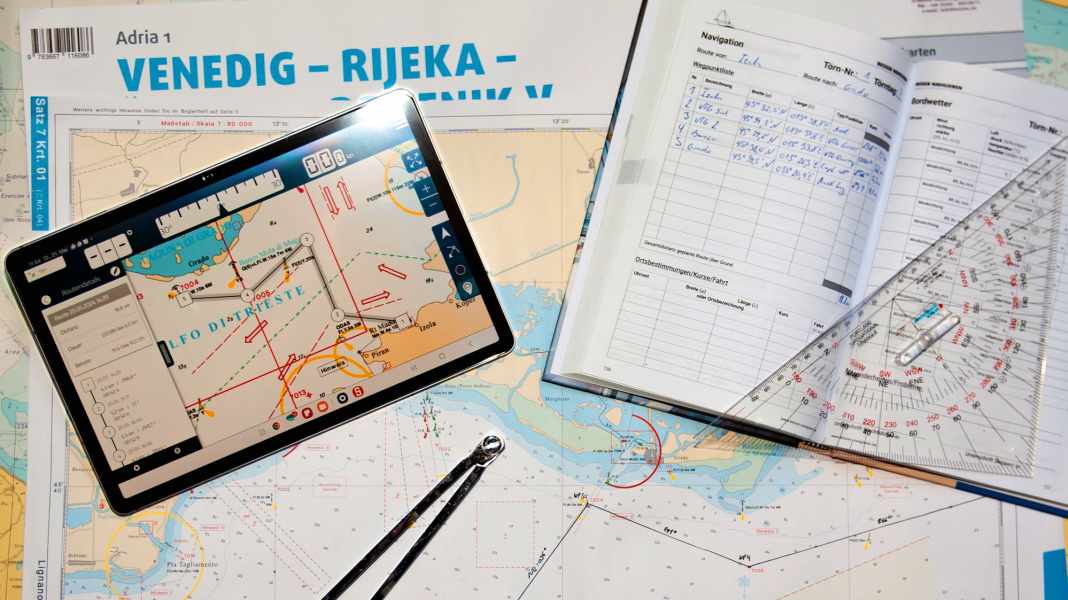
The use of GPS & Co has now become a matter of course for navigation, and hardly anyone thinks about it any more. At the same time, the technology has continued to develop, which is why we now speak of GNSS (global navigation satellite system) as a generic term for the various satellite navigation systems available.
Navigation series
- Episode 1: Terrestrial positioning
- Episode 2: From map heading to compass heading and dead reckoning
- Episode 3: The Inclusion of wind and electricity
- Episode 4: GPS waypoint navigation - tips and tricks and common mistakes
When working with GNSS devices on pleasure craft, there are still some challenges to overcome - from correctly interpreting the available data to mapping out the best route to the intended destination.
Babylon on the screen
The first hurdle is the unambiguous categorisation of the numerous data provided. Unfortunately, even elementary values in common recreational boating systems often have different designations, which applies even more so to their abbreviations. For example, a three-digit heading could either stand for the chart course or for the current direction of movement of the boat over ground or even for the direction to the next waypoint - which is not the same thing.
While we have largely equated the course over ground (KüG) with the chart course (Kk) in previous episodes, GNSS navigation requires a more differentiated approach. When we draw a course from the starting point to the destination on the nautical chart, we are talking about the intended course over ground. This chart course (Kk) describes the "target course", so to speak, and is often referred to as DTK (desired track) or with DCOG (desired course over ground) or simply with CS for course labelled.
On top of this, the GNSS device constantly determines the direction travelled by the boat over the ground - several times a second. This is usually referred to as COG for course over ground - i.e. course over ground (KüG) - and sometimes also issued as TRK for track - describes the current direction of movement of the boat. One could also speak of the "actual course".
You should also always bear in mind which donors the displayed values originate from. For example, a value displayed as heading (HDG) cannot actually come from the GNSS, as it has no relation to the boat's heading. An electronic compass must be involved here, as this is the only way to know the present heading.
Differences between the respective course data provide valuable information about a possible lateral offset, and it is precisely one of the advantages of electronic navigation that these values are always available - you just have to know how to assign them correctly.
Speed without the hustle and bustle
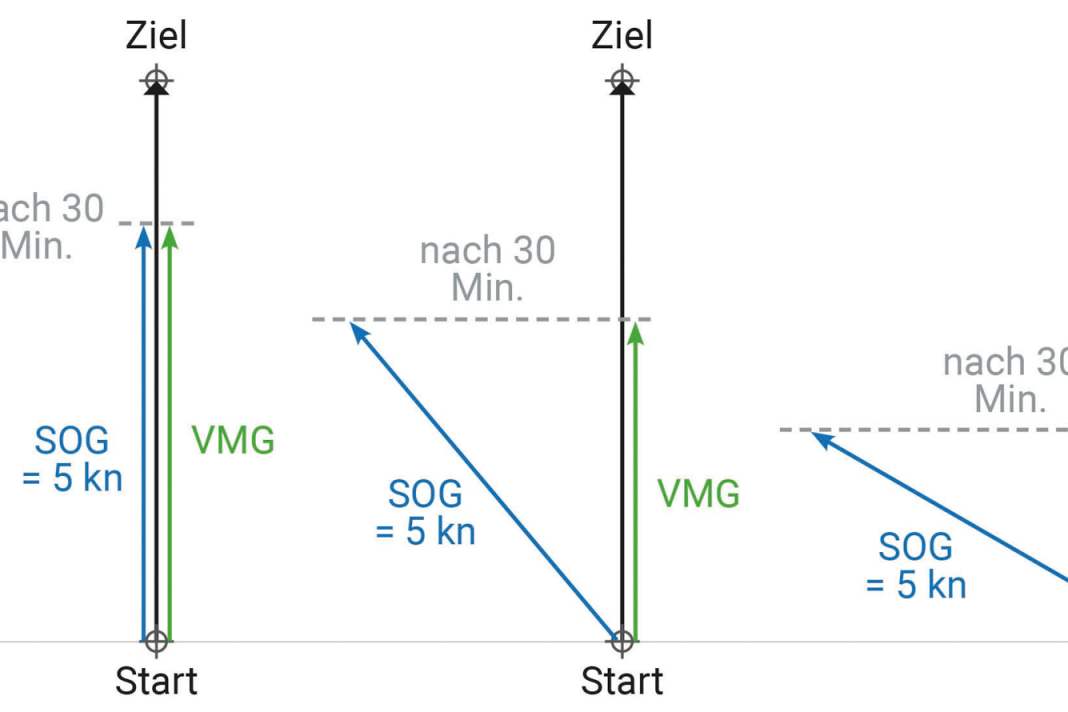




In addition to heading values, the GNSS also continuously provides the current speed over ground, usually labelled SOG (speed over ground) or simply SP for speed. It is determined on the basis of the permanent shift in position in relation to time - in the same way as ground speed (FüG) when coupling, but at much shorter intervals. The interval at which the course and speed information is updated can usually be set. This helps with hectic oscillating display values.
If a routing is running - i.e. a specific destination, such as a waypoint, has been set as a control marker - the speed travelled to the destination is also determined, which is usually calculated as VMG (velocity made good) is labelled. It describes the speed at which the boat moves towards the target. If the boat deviates from the chart course, the VMG decreases because it is no longer travelling directly towards the target. The VMG is helpful when cruising in order to allocate hole and stretch bows. On upwind courses, it can help to find the ideal compromise between height and speed.
All data supplied by the GNSS naturally relates exclusively to the movement of the boat over ground.
Navigation is scouting
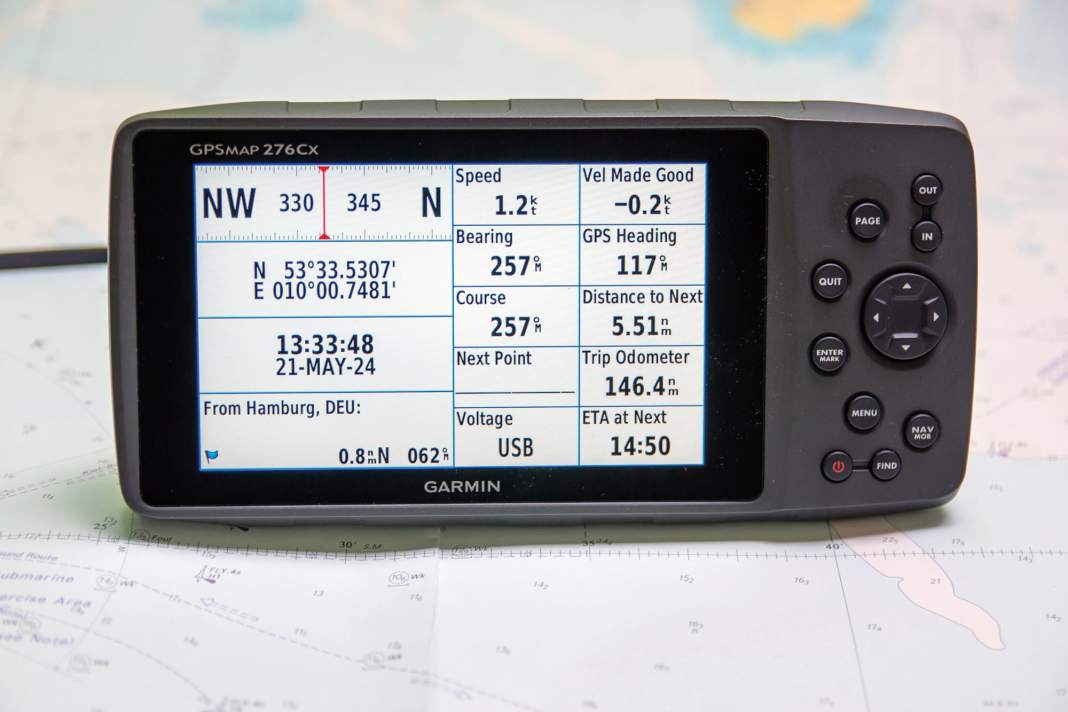





To benefit from all these functions, a route consisting of individual waypoints must first be programmed into the device. The waypoints are either defined on a paper chart and then their positions transferred to the navigation device or, in the case of plotters, set directly on the electronic chart.
The specific procedure depends on the device, so you should familiarise yourself with the most important functions in advance: How are the individual waypoints put together in the correct order to form a route? How can a waypoint position be subsequently moved, how can an additional waypoint be added to a route, how can a waypoint be deleted from a route?
With plotters, it should be borne in mind that zooming in the vector maps commonly used there is equivalent to a change of scale. When zooming out, important content can disappear in favour of clarity. As with paper nautical charts, it is therefore advisable to work at the largest available scale when planning your route. To be on the safe side, every route marked out on a plotter should be "travelled" again with the cursor at the highest zoom level before casting off.
Waypoints should be set at any point on a planned route where a change of course is imminent or where special attention is otherwise required. This could be, for example, a flat spot that needs to be avoided but passed nearby, a restricted area next to the route or even a sea mark on the route so as not to cross it.
Most devices continuously display the remaining distance and journey time to the next waypoint. If necessary, the display fields on the GNSS/plotter display should be adjusted accordingly. In addition, a proximity alarm can often be set.
The approach buoy to the destination harbour as the last waypoint also makes it possible to calculate the estimated time of arrival (ETA = estimated time of arrival). Meanwhile, setting the final destination as the sole waypoint harbours the risk of overlooking treacherous spots along the way or missing necessary course changes.
Otherwise, the choice of waypoints is at the skipper's discretion: any chart positions can be defined as waypoints or real navigation markers such as navigation marks can be used. Many sports boat chart sets also contain waypoint recommendations for popular routes.
Leave nothing out of consideration when navigating
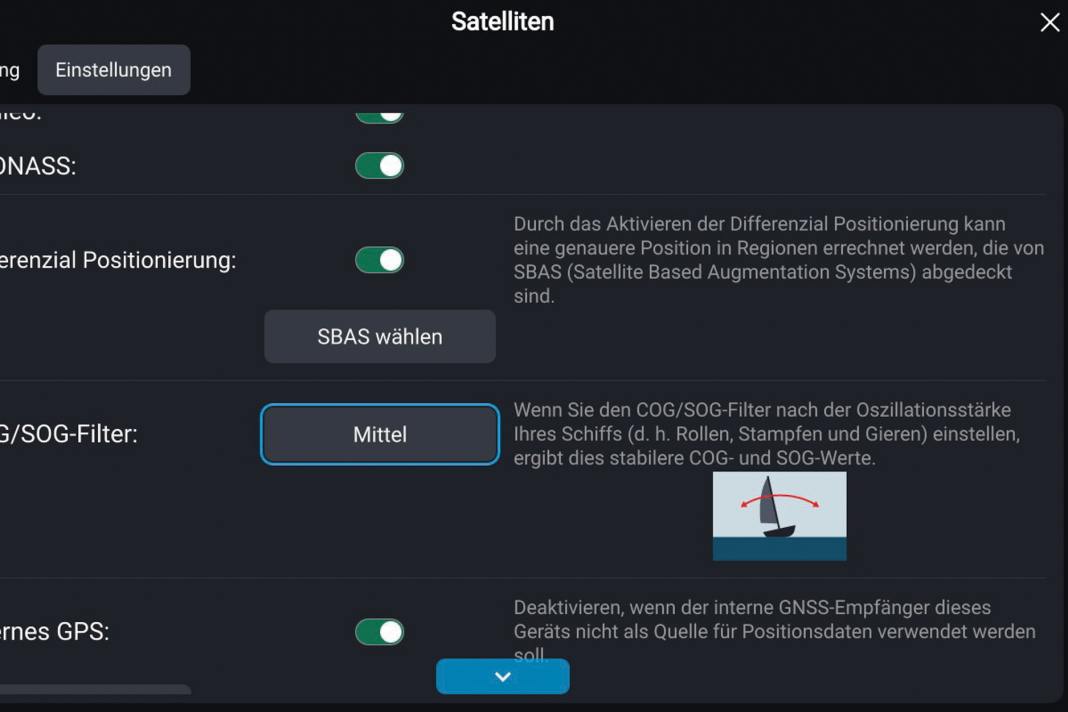


However, healthy scepticism is advisable when it comes to so-called autorouting functions. Especially as they are based on a limited database that may not take all relevant aspects into account - not to mention system-related inadequacies.
It is therefore advisable to consider the forecast wind direction and strength as well as the resulting courses to the wind when marking out the waypoints. After all, it is important to pass leeward coasts, sea marks and shoals at an appropriate distance to windward. The waypoint positions must be set accordingly. In the previous episode, we described how to calculate a suitable course ahead. However, this may be too high upwind so that the drift cannot be fully compensated for.
You should also consider any currents and the expected swell, for example in shallow areas or downwind of islands. Placing a waypoint where a ground or cross sea is to be expected could prove to be unpleasant - it is better to avoid these areas.
I have also got into the habit of writing down the waypoints of each day's route in a tabular list - good logbooks already have corresponding forms. This list not only contains the waypoint names and positions, but also the distances and map courses between the individual points. It not only serves as a backup in the event of an electronics failure, but also as a plausibility check of the values output by the GNSS.
During synchronisation, for example, it can be quickly recognised if the electronics are still controlling an "old" waypoint because it was passed at too great a distance and the device has not yet switched to the new waypoint.
Like on the motorway
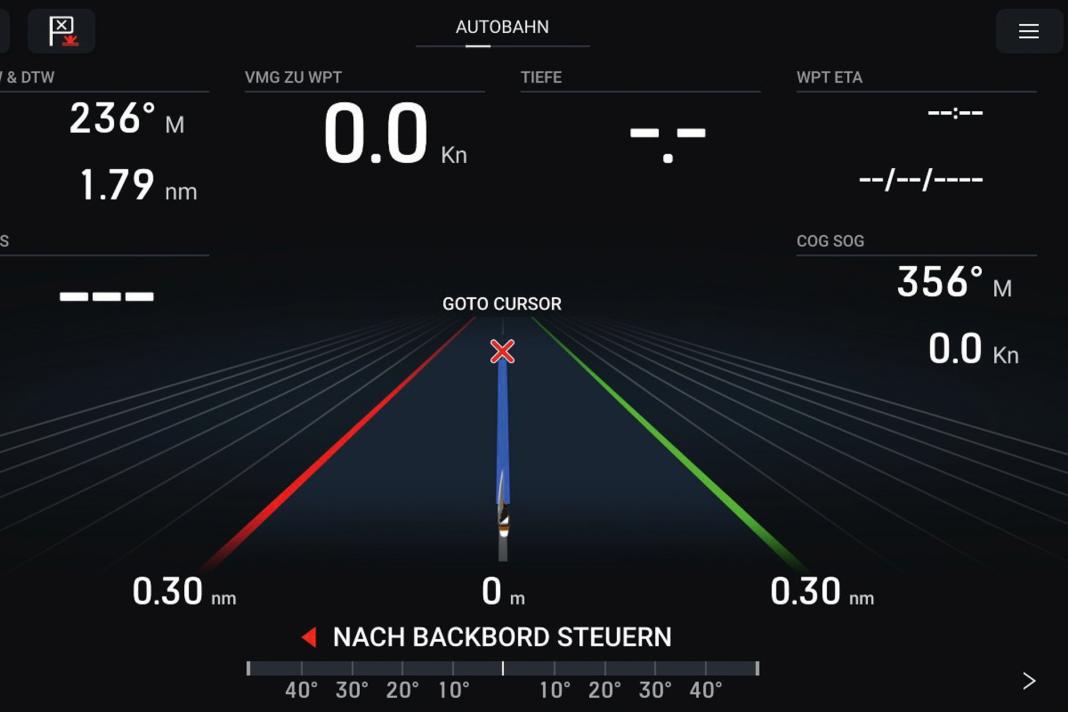


On the way, you can use the displayed values to check at any time whether everything is going according to plan. Among other things, this is done by constantly comparing the intended and the observed path over ground - i.e. between the chart course and the COG.
Most devices also offer a so-called highway display for this purpose (it is also known as a course deviation indicatorCDI for short). The centre line of the road shown illustrates the chart course. If the boat runs off course, there is a lateral course error - a lay-off.
The extent of this transverse storage can also be called up as a numerical value in nautical miles. The relevant XTE (cross track error) or XTD specification (cross track distance) provides a good reference point for estimating a lead course for an unexpected wind and/or current-induced offset. Some devices also provide recommended control values for a "heading correction".
It goes without saying that a comparison should be made with the chart each time the course is set so that you are not placed in dangerous terrain. If this threatens, a correspondingly sharp (possibly right-angled) up-course correction would be advisable.
Around the bend with the dog
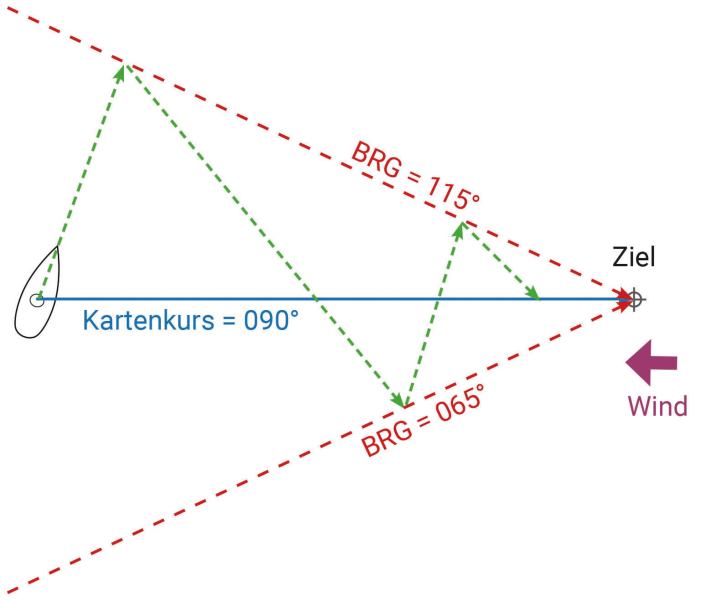
In addition, the right bearing to the currently navigated waypoint is continuously displayed as a bearing (BRG or also BTW = bearing to waypoint) is provided. If the BRG value deviates noticeably from the course over ground (COG), you may be tempted to correct the current heading to the BRG value - after all, the destination is exactly in this direction. However, this would ignore the cause of the course deviation. As a result, the COG and BRG would diverge again after a short time.
Of course, you could then correct the heading again accordingly. With this approach, however, the movement of the boat over the ground would gradually describe an arc - a so-called dog curve.
Background: If the cause of the course deviation is, for example, wind drift, the boat will be driven further and further to leeward despite regular reorientation towards the target. In the end, the target would be exactly to windward. Unless, in the meantime, you have run aground on a flat that you actually wanted to avoid with the chart course.
It is better to work with the corresponding retention rates (see episode 3) so as not to deviate significantly from the map course in the first place. The BRG display provides a further useful reference point for corresponding loading values in comparison with the chart course. In addition, for example, bearings to the target (BRG) taken from the chart and also a maximum lateral course deviation (XTD) can be set as limit values when crossing (see graphics).
If the limit value is reached, the next turn is imminent. The virtual signposts that GNSS devices permanently provide in the form of all these values have revolutionised navigation at sea. However, their usefulness stands and falls with the person who defines the most important key data. Even the best technology cannot conjure up an ideal route from a haphazardly thrown-together route and carelessly set waypoints.
Control is better
With GNSS navigation, it is worth regularly checking the accuracy of the system. This is because it depends on the number and distribution of the satellites used.
Especially as supplementary systems such as the mobile phone network, which is used by smartphones and tablets to determine their location, or plausibility aspects that car navigation systems take into account (after all, they generally travel on roads and not through houses or across fields), only work to a limited extent at sea. Ultimately, every location in the water is also a possible ship location.
Almost every nautical GNSS device offers a status display that provides information on the number and spatial distribution of the satellites in use. It often consists of a graphical representation of the satellite distribution in the sky. If the GNSS satellites currently in use are concentrated in one direction, the accuracy is likely to be low - if they are evenly distributed, the position information will be much more reliable.
The influence of the geometric satellite arrangement is often also output as a mathematical value. With this so-called DOP value (DOP = dilution of precision(i.e. "attenuation of precision") is a dimensionless number. The lower the value (e.g. below 3), the more reliable the position information can be estimated. High values, for example above 8, should be viewed critically. If several DOP values are displayed, the horizontal accuracy is decisive for nautical navigation (HDOP = horizontal dilution of precision).
One cause of unfavourable satellite distribution may be lateral antenna shadowing. Perhaps someone is sitting in front of the GNSS antenna mounted on the stern, or the boat is travelling along a steep coast. In the event of permanent shadowing, a different antenna position or the connection of an external GNSS antenna should be considered, depending on the installation on board.
While you're at it, you can also take a look at the GNSS system configuration. If the device has satellite-based supplementary systems, so-called SBAS (satellite based augmentation systems)This function should be activated if a GNSS system such as the European Egnos is supported. The parallel use of different GNSS such as GPS, Galileo and Glonass can also pay off. This can also often be configured individually. And, of course, the map datum (geodetic datum, e.g. WGS 84) should match the GNSS device and the map material used.

